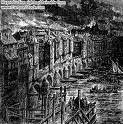Medieval LondonBy David Nash Ford
The corporation of the City of London predates even England's parliament and is based on the French model, with the ''maire'' at its head. This form of organisation was already an established principle at the time of King Stephen's imprisonment, when the people successfully demanded his release. There is no evidence of the London citizenry of the time being recognised as a corporate entity but there were strong examples to be followed in the great merchant cities of France and Flanders.
The strength of the Mayoralty in London was confirmed under Richard the Lionheart and even more during his absence on crusade, under the future King John's regency. The mayor's authority, supported by his aldermen and councilmen was given such a firm basis that it still continues in much the same form. London was made the first municipal corporation in England, later emulated by 28 medieval towns in their own charters.
Londoners were always willing to take the opportunities presented by power struggles within the national government. John, brother of Richard I, was able to win unaccustomed support in his opposition to Longchamp, Richard's ruthless representative, by accepting the ''commune'' of London. This was ultimately to lead, in 1191, to the meeting of the English Barons with the Citizens of London and their removing Longchamp in order to bring John to power. At this point John kept his word and publicly recognised the commune, agreeing to respect the rights of all those involved. It is not entirely clear what led to this exceptional event, but civil unrest is widely suspected. At this time many individual territories, or sokes, with their own jurisdiction would have existed within the area and the transition for these would have been particularly problematic.
The first record of a London mayor, Henry FitzAilwyn, is not until 1193. His term of office was to last until his death in 1212. Some aldermen, particularly those with major land holdings, were especially powerful and held great influence in the choice of the mayor. It is clear that from Edward I's reign, the aldermen formed the prime decision-making group and from this group the mayor has always been chosen.
The Lord Mayor's Show, a popular annual spectacle, derives from the original 'ridings' to Westminster, to obtain approval from the monarch or his minister for the people's choice of mayor. This election had been instituted as a result of King John's charter in 1215, which gave Londoners the right to choose their own leader.
London's mayor was amongst the treasurers of Richard the Lionheart's ransom. During the troubles of King John's reign, London supported the Rebel Barons. The City even allowed them within the city walls and provided them with troops and money. These barons were led by Robert FitzWalter, 'Castellan' of the city's western riverside fortress of Baynard's Castle. The Magna Carta gave responsibility to both the Mayor of London and FitzWalter for upholding the terms of the charter and thus protecting the liberties of the city.
The reigns of Henry III and Edward I mark a period of unrest in London, during which more than one mayor was removed from power and replaced by a royal warden. This tendency for London to be 'taken into the king's hands' may reflect the inclination of the people to oppose the harsher monarchs. Indeed a band of Londoners supported Simon de Montfort against Henry III at the Battle of Lewes in 1264. Both kings were obliged for a period to rule London through their 'custos', Henry from 1265 to 1270 and Edward from 1285 to 1298.
Our documentation for the 13th century, in London, is much more complete, particularly towards the end of the century. To supplement the chroniclers' narratives, we have the contemporary archives of the City, including the Letter Books begun under Edward I, rolls from the mayor's court and the 'Hustings' court and citizens' wills. From these, we can learn a great deal about the social and professional lives of Londoners, as well as the structure of the city. The crowded city clustered along the riverbank, with a small settlement across the river in Southwark.
Being so cramped, the city was regularly devastated by fire. To limit the dangers that this posed, FitzAilwyn, the first mayor, introduced the first Building Act. Stone was to be used for partitioning walls and thatched roofs were prohibited. However, it was some time before these principles were widely put into practice. We can gain a good picture of the buildings of the time from plans which have survived to this day.
To the west of the city walls lay the western liberty, a site of many town hostels for religious groups. By 1189 the Knights Templar had moved from Holborn and constructed their Round Church near the Thames. However, in 1312, their order was suppressed and their successors, the Hospitallers, leased many of their buildings to London lawyers. These were the beginnings of the Inns of Court and Chancery: hostels for barristers and students which took on the role of a University in the city. The four most ancient are the Inner (1312) and Middle Temple (1320), Lincoln's (c.1348) and Gray's (1370) Inn. They taught history, music and dancing, as well as the law, to medieval and later students and still retain today the exclusive right to provide barristers for the English Courts. The London legal system would have sent criminals to prisons such as Newgate established by the 12th century, adjoining one of the eight medieval gateways into the City. Executions took place at Smithfield and, from 1388, at Tyburn.
Subscribe to:
Post Comments (Atom)

No comments:
Post a Comment